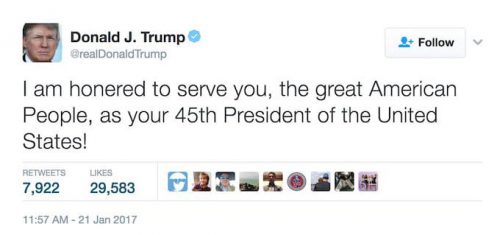Anyone can blunder their way into a tech fail—even the leader of the free world. But when we respond to a chat in all caps, or bad-mouth someone after a conference call and realize that person is still on the line, it doesn’t whip up international headlines. When a sitting president makes a mistake, especially one involving technology, it reminds us that we’re all human, we all mess up, and we all wish we had a chance to do it over again.
So, this Presidents’ Day, we wanted to review some particularly funny presidential tech fails. We limited these highlights to sitting presidents during their terms of office. The hope is that we can glean some useful lesson from them.
#1. Trump Tweet
Even before he took the oath of office, our new president was considered to be a poster child for communications and media gaffes. But we’re going to forego any campaign shenanigans and draw your attention to a tweet from President Donald Trump’s first full day in office:

The tweet issued from Trump’s personal @realDonaldTrump account, the one he used throughout his campaign. It wasn’t long before he scrubbed the tweet and replaced it with the same message, only with “honored” spelled correctly.
Now, Trump certainly isn’t the first Twitter user to misspell a word or delete an embarrassing tweet. However, this is the first time he did so as president, and some news commentators question whether social media posts represent presidential correspondence, which, by law, should be archived. Whatever the case may be here, this is plainly a situation that shows how vital it is to review any post or email before hitting the “Submit” or “Send” button.
#2. Obama DVDs
Part of President Barack Obama’s appeal was his social-media skill and cosmopolitan style. He was touted as the “first politician to truly understand the power of social media and to use it . . .” So it came as a real surprise when the tech-savviest president to date stumbled into an embarrassing flap involving then British Prime Minister Gordon Brown.
During a 2009 visit to the U.S., Brown and Obama exchanged gifts. Brown’s gifts included a pen holder crafted from the salvaged timbers of the HMS Gannet, an anti-slavery warship. It’s sister ship, the HMS Resolute, provided the materials for the Resolute desk in the Oval Office.
Obama’s gift to Brown? A set of 25 DVDs of classic American movies.
According to the Daily Mail, this wasn’t a gift pulled from a Best Buy bargain bin, but rather was assembled by special request by the American Film Institute. But this incident still caused a bit of an uproar on the other side of the Atlantic.
But that’s not the best part. Here’s where the “tech” aspect comes into play. As it turns out, the DVD players in the US and Europe use different display formats. According to The Telegraph, “when the PM settled down to begin watching [the DVDs] he found . . . . the films only worked in DVD players made in North America and the words ‘wrong region’ came up on his screen.”
The lesson in this? Whether you’re handing over DVDs (or an iPod) as a gift, or gearing up for a video conference, test out the technology first. Make sure it works and that you’re familiar with the controls so you don’t get tripped up on technical details later.
#3. Bush Jargon
President George W. Bush is renowned for flubbing words and sentences. Is it any wonder when he messes up references to everyday technology? Throughout his time in office, he often referred to “the Internets” and claims that he used “the Google.”
Sure, this is funny, but it’s also a reminder that when you’re discussing any highly technical topic, make sure you’re up to date on common terms and how to use those terms. And when you’re discussing the topic with a client, you might want to leave the jargon behind altogether. However, you still need to be familiar enough with the jargon that you can repackage it in everyday phrasing.
#4. Clinton Email
President Bill Clinton is credited with sending the first email from the White House. He also carries the dubious honor of being the first president to breach the unofficial email code of conduct, or “netiquette.”
In the (alleged) first email ever sent from the White House to a foreign leader, Clinton sent a reply to the prime minister of Sweden, Carl Bildt, congratulating him on lifting an Asian trade embargo. The official transcript of the correspondence shows a perfectly normal email. What it doesn’t show is the original format of the email. Apparently, Clinton wrote the email using ALL CAPS, which in email-speak is like shouting at the reader.
So when it comes to “new” forms of communication—including social media, email, video and audio conferencing, and chat—it’s important to brush up on your basic dos and don’ts.
#5. Reagan Missiles
President Ronald Reagan was called the “The Great Communicator” because of his knack for bypassing the media and talking directly to the nation. Another reason was because of his ability to toss off catchy quips and off-the-cuff remarks.
One such off-the-cuff remark put the Soviet Union on alert. On August 11, 1984, Reagan sat down to make his weekly Saturday address. He tossed off a joke during a soundcheck, and it went like this: “My fellow Americans, I’m pleased to tell you today that I’ve signed legislation that will outlaw Russia forever. We begin bombing in five minutes.”
The myth is that this was accidentally broadcast over the air, the Soviets heard it and went to their equivalent of DEFCON 1. The truth is, the joke was leaked to the public and later published, and the Soviet Union responded by temporarily placing military units on high alert.
Whether you think Reagan was reckless or the Soviets simply couldn’t take a joke, just be sure to watch what you say on a conference call. Even when you think you’re muted or that the call is over, you could still fall victim to a “hot mic.”
The point is, tech fails can happen to anyone. No one goes through life without experiencing an embarrassing moment, usually in front of an audience. The best way to avoid them is to do your homework beforehand. Take any new or unfamiliar tech for a test drive before a meeting or presentation. And study up on any common courtesy or etiquette involved with the technology. Jive offers you plenty advice on that when it comes to email, video conferences, and conference calls.
If you have a funny tech fail story of your own, presidential or otherwise, please share it in the comments.

